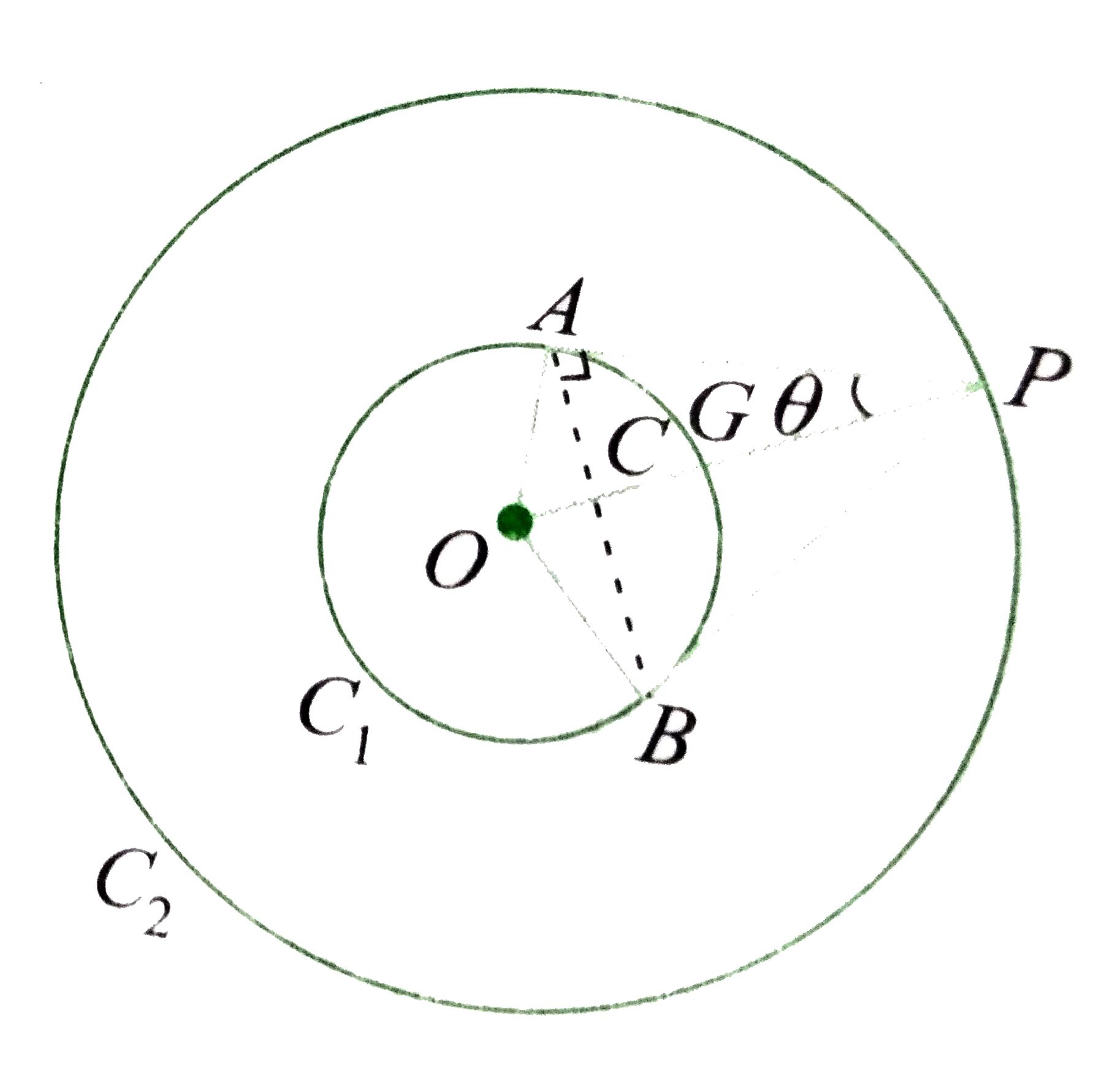C1andC2 are two concentrate circles, the radius of C2 being twice that of C1. From a point P on C2 tangents PA and PB are drawn to C1. Prove that the centroid of the ΔPAB lies on C1
Let r be the radius of C1 and 2r be the radius of C2.Then, OA=OB=r
and OP=2r
Since PA and PB are tangents to C1,
∠OAP=∠OBP=90∘
Let OP meets C1 at G.
Let ∠OPA=θ. Then,
sinθ=OAOP=r2r=12
or θ=30∘
or ∠AOP=60∘
In ΔOAC,
cos60∘=OCOA
or 12=OCror OC=r2
∴PC=2r−r2−3r2
Also, CG=r−OC=r−r2=r2
Clearly, CG=13PC
Therefore, G is the centroid of ΔABP.

Topper's Solved these Questions
- CIRCLE Book:CENGAGEChapter:CIRCLE Exercise:Exercise 4.1
Explore 14 Videos
- CIRCLE Book:CENGAGEChapter:CIRCLE Exercise:Exercise 4.2
Explore 5 Videos
- BINOMIAL THEORMBook:CENGAGEChapter:BINOMIAL THEORMExercise:Question Bank
Explore 31 Videos
- CIRCLESBook:CENGAGEChapter:CIRCLESExercise:Question Bank
Explore 32 Videos
Similar Questions
C1 and C2 are two concentric circles, the radius of C2 being twice that of C1. From a point P on C2, tangents PA and PB are drawn to C1. Then the centroid of the triangle PAB (a) lies on C1 (b) lies outside C1 (c) lies inside C1 (d) may lie inside or outside C1 but never on C1
View SolutionIf radius of circle C1 is 2 times the radius of circle C2, then ratio of area C1 to that of C2 is
View Solution
Knowledge Check
C1andC2 are two concentric circles with centres at O. Their radii are 12 cm and 3 cm respectively. B and C are the points of contact of two tangents draw to C2 from a point A lying on the circle C1. Then the area of the quadrilateral ABOC is-
A9√152cm2B12√15cm2C9√15cm2D6√15cm2C1andC2 are two concentric circles with centres at O. Their radii are 12 cm and 3 cm respectively. B is the point of contact of tangents drawn to C2 from a point A lying on the circle C1. Then the area of the triangle OAB is :
A9√152 sq. cmB12√15 sq. cmC9√15 sq. cmD6√15 sq. cmConsider the circle C1:x2+y2−6x−8y+15=0,C2:x2+y2−6x−8y+20=0 Now from any point P on C1, pair of tangents PA and PB are drawn onC2. Then locus of the orthocenter of triangle PAB is
Ax2+y2−6x−8y+20=0Bx2+y2−6x−8y+10=0Cx2+y2−6x−8y+5=0Dnone of these
C1andC2, are the two concentric circles withradii r1andr2,(r1<r2). If the tangents drawnfrom any point of C2, to C1, meet again C2, at theends of its diameter, then
View SolutionCircles C1 and C2 are externally tangent and they are both internally tangent to the circle C3. The radii of C1 and C2 are 4 and 10, respectively and the centres of the three circles are collinear. A chord of C3 is also a common internal tangent of C1 and C2. Given that the length of the chord is m√np where m, n and p are positive integers, m and p are relatively prime and n is not divisible by the square of any prime, find the value of (m + n + p).
View SolutionLet C1andC2 be externally tangent circles with radius 2 and 3 respectively. Let C1andC2 both touch circle C3 internally at point A and B respectively. The tangents to C3 at A and B meet at T and TA = 4, then radius of circle C3 is :
View SolutionLet C1 and C2 be two circles with C2 lying inside C1 . A circle C lying inside C1 touches C1 internally and C2 externally. Identify the locus of the centre of C.
View SolutionFrom a point P outside a circle with centre at C, tangents PA and PB are drawn such that 1(CA)2+1(PA)2=116, then the length of chord AB is
View Solution
